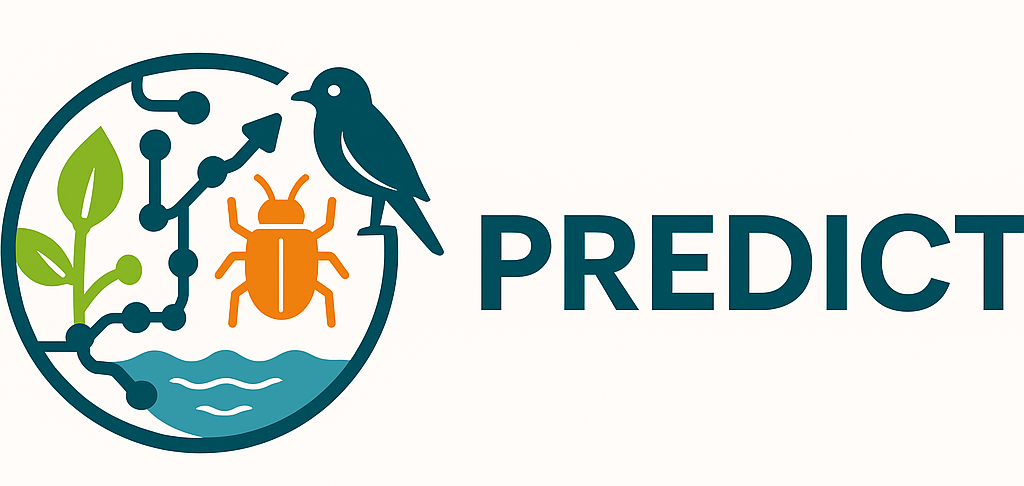Science clusters


Summary
Europe has made significant progress in open ecological observation and network science through research infrastructures (RIs) such as GBIF, ICOS, and eLTER. However, while data collection and retrospective analyses are now well established, the ability to anticipate ecological change remains limited. PREDICT addresses this challenge by developing an open, interoperable, and scalable cyberinfrastructure for ecological forecasting, building on the capabilities of LifeWatch ERIC. The project integrates ecological data from diverse monitoring networks into modular forecasting workflows, openly accessible to researchers and decision-makers, to provide dynamic, near-term predictions of ecological states and processes under varying climate, land-use, and socio-economic scenarios.
In-kind contributors: University of Potsdam, Finnish Meteorological Institute, Bangor University, Swiss Federal Institute of Aquatic Science and Technology
Challenge
Ecological forecasting can generate important actionable insight for policymakers and also advance ecological theory. Despite the wealth of environmental data, progress in forecasting
natural systems to inform decision-making remain limited. Most RIs prioritise data collection rather than actionable forecasting, and valuable local datasets that would support predictions are not well integrated with larger systems. Moreover, forecasts are rarely translated effectively into policy and management contexts due to limited engagement with societal needs and perceptions. As a result, forecasting workflows are often isolated, non-standardised, and underutilised in policy and management.
Solution
PREDICT will expand ecological forecasting capabilities with rich and integrated European data. It will do so by developing and deploying an open, reusable, interoperable, and scalable cyberinfrastructure for forecast cataloguing, evaluation, and dissemination.
The project will harness the capabilities of LifeWatch ERIC and - building on its services- will integrate multiple open ecological datasets from diverse monitoring schemes (GBIF, ICOS, eLTER, bird monitoring, national parks, herbariums, and European sites in the Global Lake Ecological Observatory Network - GLEON) into modular forecasting workflows - openly accessible to the research community and embedded within societal contexts to support decision-making.
The project will use open metadata standards for forecasts and observations.
It will establish composable forecasting pipelines using machine learning and other tools, ensuring interoperability across spatial and thematic scales.
Continuous forecast validation and evaluation will be implemented - scoring against new data, and benchmarking against alternative models of climate, land-use, and socioeconomic change, integrating services from the ClimateADAPT RI.
Finally, a dynamic dashboard for visualisation and public access will be set up, allowing seamless incorporation of future datasets from newly established RIs, such as eLTER - promoting interoperability and scalability across Europe.
Scientific Impact
PREDICT will advance the predictive capacity of European environmental sciences by generating forecasts that contribute to a synthetic understanding of patterns of predictability in ecology. The iterative nature of near-term ecological forecasting - evaluating forecasts with new observations, updating models, and then making new forecasts - has the potential to accelerate learning and enable proactive environmental decision-making.
Doing so with European datasets - in collaboration with data producers, researchers, forecasters, practitioners, and decision and policymakers - will increase the capacity to fully exploit the growing volume and variety of available data.
Social science expertise will be instrumental in ensuring that forecasts are not only technically sound, but also usable, trusted, and actionable in policy and management contexts. Ultimately, PREDICT will advance our ability to anticipate and respond to environmental challenges facing European society, including facilitating adaptive management at a European scale.
PREDICTS aligns closely with the aims of the ENVRI Community and the broader goals of OSCARS: promoting open science, empowering data-intensive research, and delivering composable services for the European Research Area.
Principal investigator

Maria Paniw is an internationally recognised expert in predicting global-change effects on natural populations. Her research integrates long-term data on plants and animals with advanced statistical and mechanistic models to predict how populations in drylands respond to extremes and human pressures. Maria's research has always emphasised the importance of reproducible science, and she has dedicated several projects to increasing accessibility of data and models.


